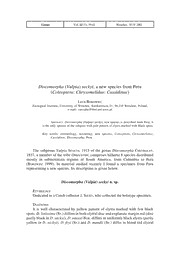
Discomorpha (Vulpia) seckyi, a new species from Peru (Coleoptera: Chrysomelidae: Cassidinae) PDF
Preview Discomorpha (Vulpia) seckyi, a new species from Peru (Coleoptera: Chrysomelidae: Cassidinae)
Genus Vol. 12 (1): 59-61 Wroc‡aw, 10 IV 2001 Discomorpha (Vulpia) seckyi, a new species from Peru (Coleoptera: Chrysomelidae: Cassidinae) LECH BOROWIEC Zoological Institute, University of Wroc‡aw, Sienkiewicza 21, 50-335 Wroc‡aw, Poland, e-mail: [email protected] ABSTRACT. Discomorpha (Vulpia) seckyi, new species is described from Peru. It is the only species of the subgeus with pale pattern of elytra marked with black spots. Key words: entomology, taxonomy, new species, Coleoptera, Chrysomelidae, Cassidinae, Discomorpha, Peru. The subgenus Vulpia SPAETH, 1913 of the genus Discomorpha CHEVROLAT, 1837, a member of the tribe Omocerini, comprises hitherto 6 species distributed mostly in submountain regions of South America, from Colombia to Peru (BOROWIEC 1999). In material studied recently I found a specimen from Peru representing a new species. Its description is given below. Discomorpha (Vulpia) seckyi n. sp. ETYMOLOGY Dedicated to a Czech collector J. SECKY, who collected the holotype specimen. DIAGNOSIS It is well characterized by yellow pattern of elytra marked with few black spots. D. latissima (SP.) differs in both elytral disc and explanate margin red (disc partly black in D. seckyi), D. onorei BOR. differs in uniformly black elytra (partly yellow in D. seckyi), D. fryi (SP.) and D. mandli (SP.) differ in blood red elytral 60 LECH BOROWIEC pattern (yellow in D. seckyi). D. gassneri (SP.) and D. speciosa (BALY) have yellow elytral pattern like in D. seckyi, but D. gassneri differs in elytra with short erect hairs (bare in D. seckyi) and yellow pattern of explanate margin not or only slightly reaching lateral parts of disc (partly yellow sides of disc in D. seckyi); D. speciosa differs in especially coarse elytral puncturation (distinctly finer in D. seckyi, like in D. mandli) and yellow spot on marginalia marked with sparse black puncturation (only with few black spots in D. seckyi). DESCRIPTION Length: 16.5 mm, width: 16.6 mm, length of pronotum: 4.5 mm, width of pronotum: 9.6 mm, length/width ratio: 1.01, width/length ratio of pronotum: 2.13. Body almost circular in outline, c. as wide as long (fig. 1). Head, pronotum and scutellum black. Elytral disc in basal part and along sutural third black, on sides yellow; the yellow spot in the widest part extending to third row of punctures, in middle marked with three large, black spots. Explanate margin of elytra mostly yellow, with broad, black margin of regular border, in anterior half with two brown spots, smaller than spots of sides of disc. Some of large punctures of explanate margin indistinctly infuscate. Ventrites mostly black, venter of pronotum, close to sides of head with yellow spot, also lateral plates of mesosternum mostly yellow. Legs bicolours, fore black with 1-3. Discomorpha seckyi: 1 - dorsal, 2 - lateral, 3 - antenna DISCOMORPHA (VULPIA) SECKYI N. SP. 61 yellow ventral half of femora and tibiae, mid black with partly yellow ventral side of femora, hind mostly black with yellow spot only in apical part of ventral side of femora. Antennae mostly black, segments 1-6 with yellow ventral side. Pronotum typical for the subgenus, very broad, c. 2.13 times wider than long, with bisinuate anterior margin. Disc of pronotum on sides with distinct impres- sion, and very fine median sulcus. Surface of both disc and explanate margin bare, impunctate, slightly dull. Scutellum triangular, its surface dull. Elytral disc unevenly convex, elevated in postscutellar area (fig. 2). Postscutellar impressions shallow but distinct, bordered laterally by slightly elevated third interval. Puncturation on black part of disc moderately coarse and moderately dense with distance between punctures as long as or slightly longer than puncture diameter; on yellow part of disc puncturation distinctly finer and sparser than on black. Puncturation only in sutural part tends to form three rows, on other parts of disc irregular. Surface between punctures slightly dull, only on top of postscutellar elevation slightly glabrous. No marginal row. Explanate margin very broad, widest in 1/3 length, then regularly rounded posterad. In the widest part margin as wide as 3/4 width of each elytron. Surface of explanate margin slightly dull, with several coarse but very sparse punctures. Whole surface of elytra bare. Ventrites with no diagnostic characters. Antennae extremely long, length ratio of antennal segments: 100:50:80:90:90:80:240:210:220:200:280 (fig. 3). MATERIAL Holotype: “PERU, Iquitos, VII-VIII 1999, J. Secky lgt.” (preserved at Na- tional Museum, Prague, Czech Republic). ACKNOWLEDGEMENTS I would like to express my sincere thanks to M. OUDA (Plasy, Czech Repub- lic) for the loan of this interesting specimen. REFERENCE BOROWIEC, L., 1999. A world catalogue of the Cassidinae (Coleoptera: Chrysomelidae). Biologica Silesiae, Wroc‡aw, 476 pp.
